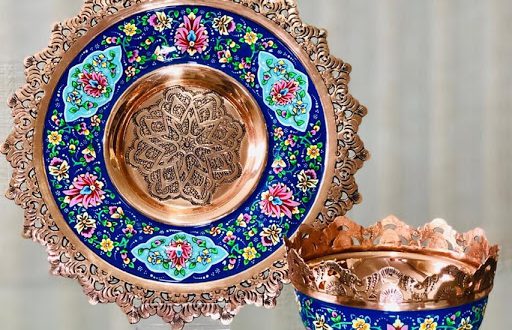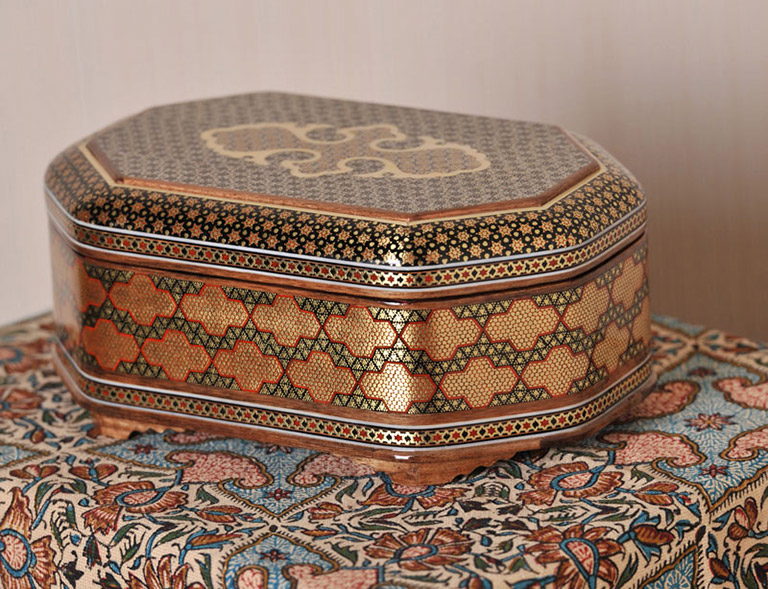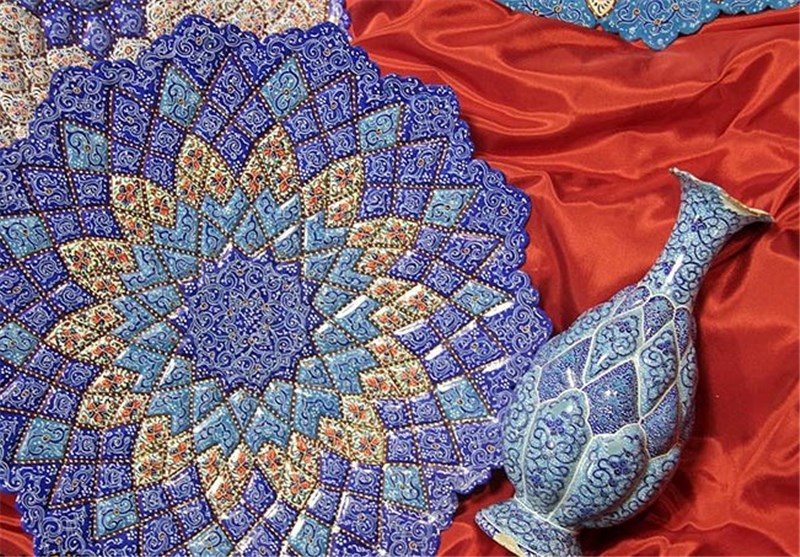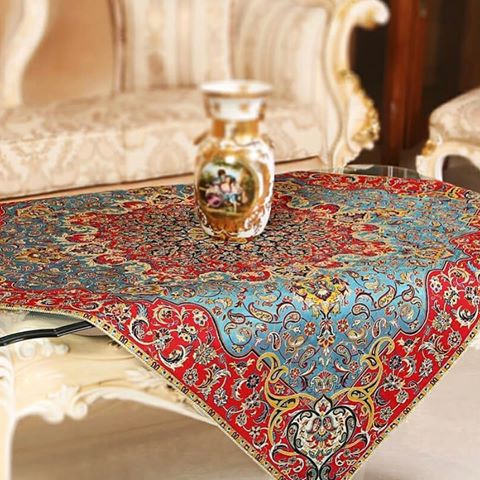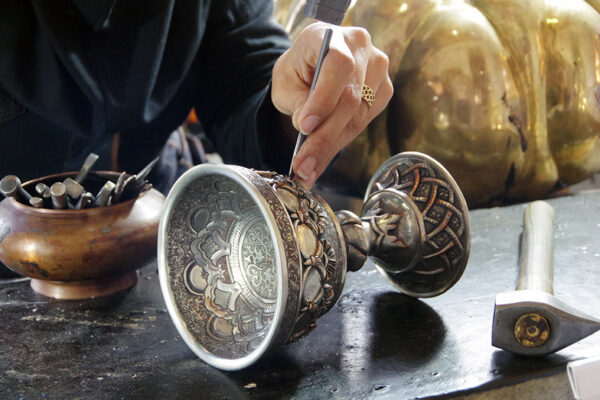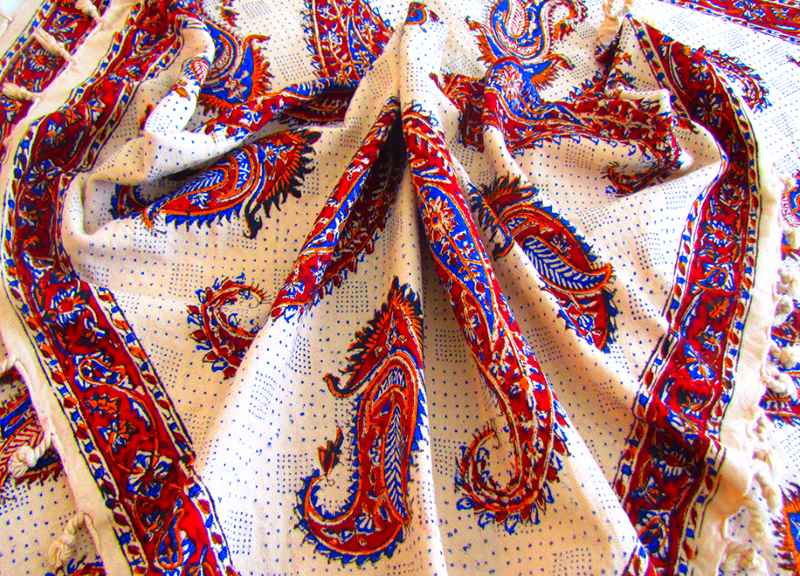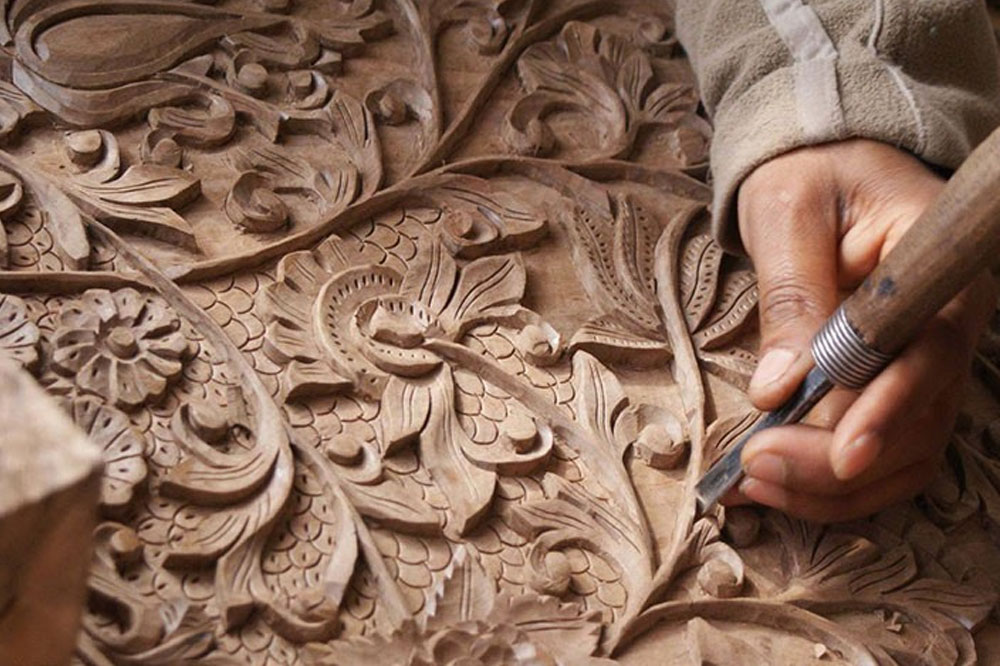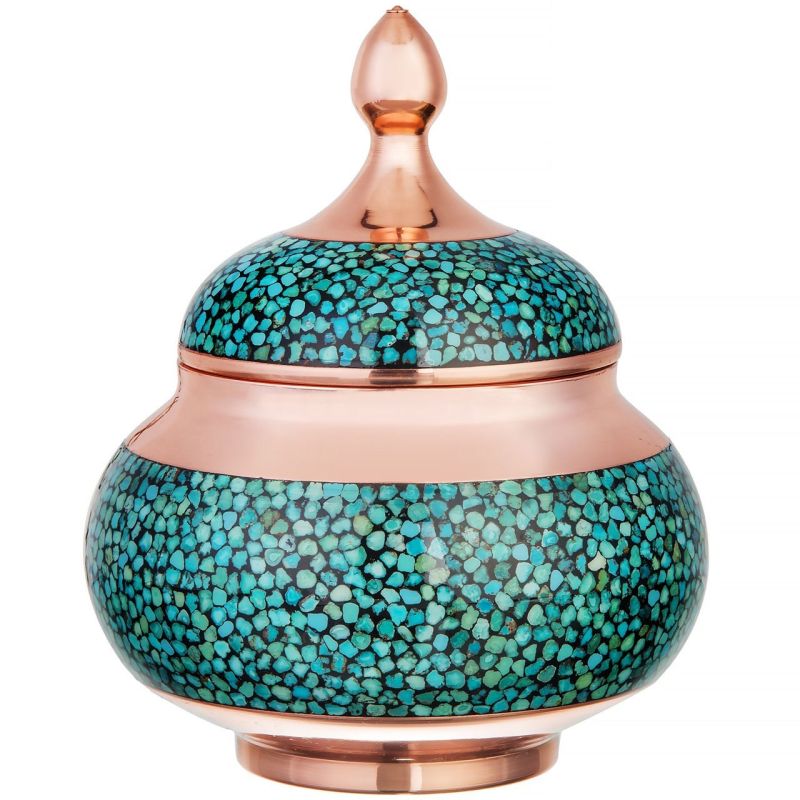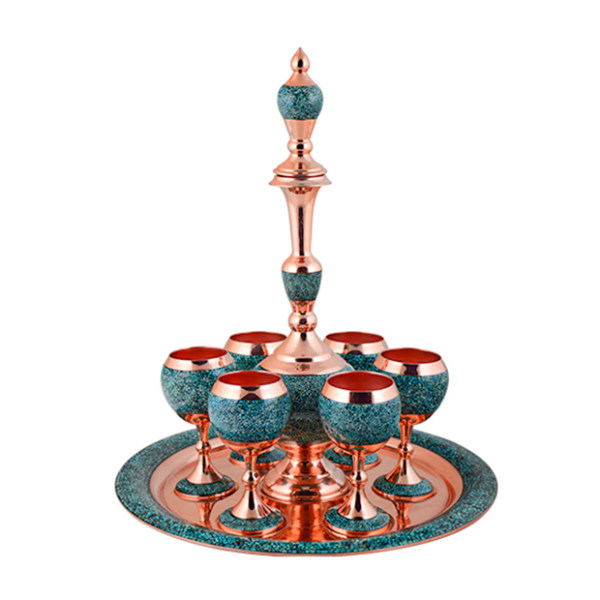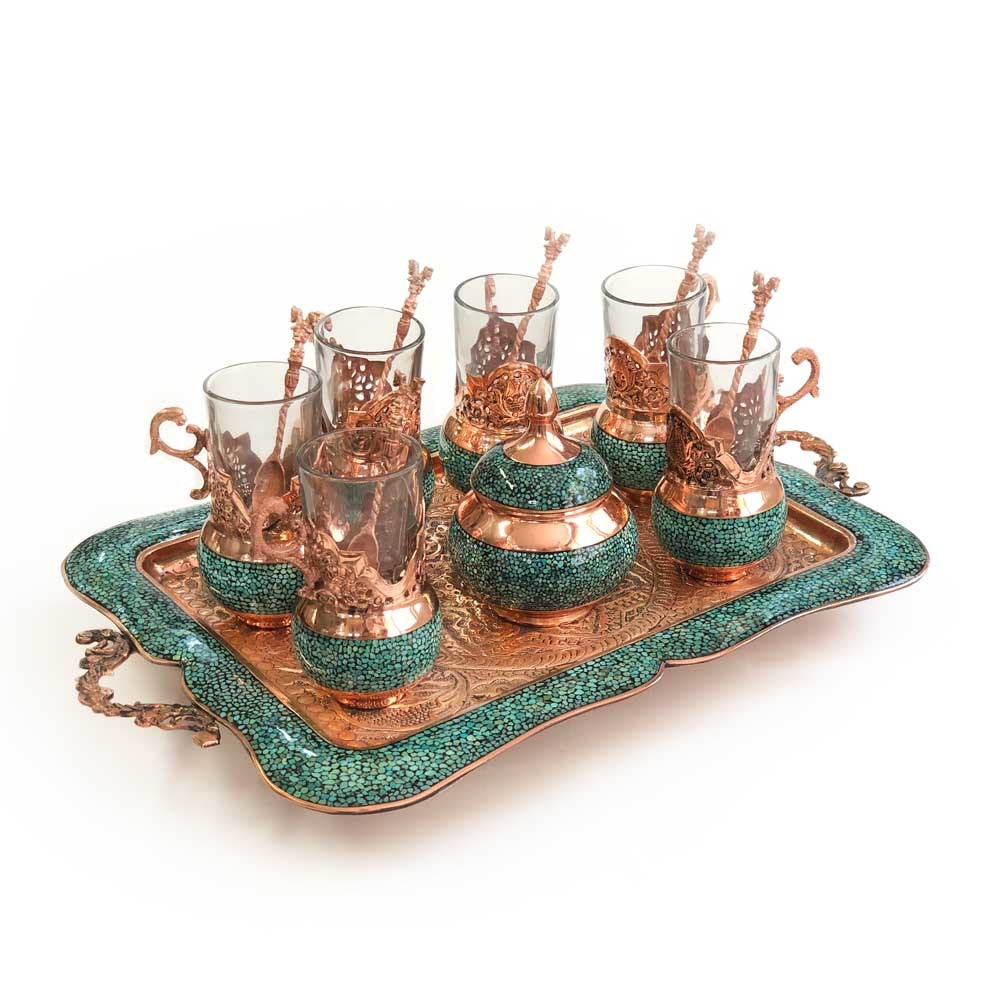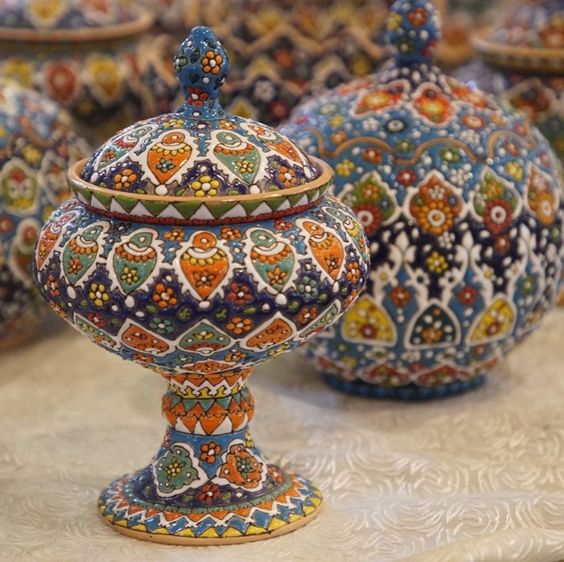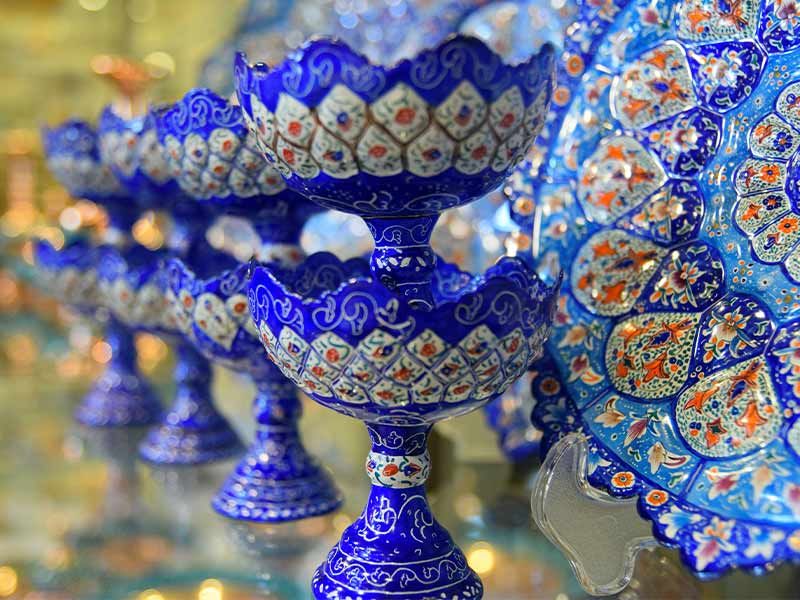
About
Our Handicrafts Products In Commerical Department
Bamik Commerical is B2B bussines that exports nuts and handicrafts from Iran to other countries such as Canada, Germany, France and etc.

Handicrafts
Firoozeh koob
About Firoozeh Koobi
Turquoise Inlaying or Firoozeh Koobi both on jewellery and containers include a copper, brass, silver, nickel or bronze object on parts of the surface of which small pieces of turquoise are set in mosaic fashion thus giving the object a special glamour. The production of Turquoise Inlaying includes two general stages: Goldsmith is making and preparation of the object intended for Turquoise Inlaying using one of the metals indicated above. Turquoise Inlaying correct placement of turquoise chips on the metal so that it is strong enough and the chips do not come off while burnishing the work.
Among the most exquisite handicrafts of Iran, Firoozeh Koubi is a very popular one. This Iranian handicraft is one of the Iran souvenirs produced by a large number of Persian handicraft suppliers. In turquoise inlaying art, small pieces of turquoise are set in mosaic fashion on the surface of various metals (coppers, brass, silver, and gold) to give the object a special glamor. Not only decorative dishes and utensils but also elegant accessories, including necklaces, rings, earrings, etc., can be ornamented by the small pieces of this precious gemstone. Turquoise stone inlaid dishes are among the most cost-effective handicraft in Iran, and many foreigners purchase them during their Iran shopping.
About Turquoise stone
It is one of the precious stones that has been discovered from ancient times in Iran. Precious jewelries were made of this
stone and given to the kings and queens as a gift.
Turquoise stone is being used in making rings, jewelry and courtier dishes.
The best and most famous kind of turquoise stone is from Neishabour that was extracted from the mine since 2000 years
ago. This city has one of the most famous turquoise mine in the world.
The color of this stone is usually sky blue, green and light blue. The best kind of this stone is dark blue one which has
more value.
Turquoise color that has been used in architectural and historical and contemporary monuments comes from the col or of
this precious stone. This color has been used in traditional arts of Iran like Tile works and is
traditional symbol of Iran which is being used in Iranian paintings.
Characteristics of Turquoise Stone:
This stone absorbs positive waves and disappear negative waves. Turquoise removes stress, fear and
depression. Many countries believe in cure benefits of this stone
Turquoise stone & copper candy/nut pedestal bowl dish
- Goldsmith is making and preparation of the object intended for turquoise inlaying using one of the metals indicated above.
- Turquoise inlaying correct placement of turquoise chips on the metal so that it is strong enough and the chips do not come off while burnishing the work.
TURQUOISE INLAID VASE
- The price is for one vase
- Beautiful Persian handicraft
- This vase is made of turquoise stone and copper
- Hard product and resistance to reshape
- Resistance to oxidation
Turquoise Inlaid Candy Dish
- Nice handmade pedestal candy dish
- Fix color
- The base of the product is copper and turquoise stone
- Persian handcraft
- It can be used either as a candy dish or decorative element
TURQUOISE INLAID (FIROOZEHKOOBI) SAKE JUG
- Goldsmith is making and preparation of the object intended for Turquoise Inlaying using one of the metals indicated above.
- Turquoise Inlaying correct placement of turquoise chips on the metal so that it is strong enough and the chips do not come off while burnishing the work.
TURQUOISE INLAYING (FIROOZEHKOOBI) SUGAR/CANDY POT
- Beautiful Persian handicraft
- This sugar bowl is made of turquoise stone and copper
- It has a lid to keep sugar better
- Hard product and resistance to reshape
- Resistance to oxidation
Turquoise inlaid candle holder
- One candleholder
- Fix color
- The base of the product is copper and turquoise stone
- Persian handcraft
Candy compote with pedestal
- Luxury turquoise in laying dish
- The base of the product is copper and turquoise stone
- It is a precious handcraft
- It can be used either as a luxury dish or as a decorative element
- It is made of copper and turquoise stone which are set in mosaic on the surface of the dish
- Resistant to oxidation
Turquoise inlaying Kashkul
- Goldsmith is making and preparation of the object intended for Turquoise Inlaying using one of the metals indicated above.
- Turquoise Inlaying correct placement of turquoise chips on the metal so that it is strong enough and the chips do not come off while burnishing the work.
Turquoise inlaying drinking set
- Fix color
- The base of the product is copper and turquoise stone
- Persian handcraft
Turquoise inlaying tea set with round engraving tray
- Fix color
- The base of the product is copper and turquoise stone
- Persian handcraft
Turquoise inlaying decanter-like jug
- Fix color
- The base of the product is copper and turquoise stone
- Persian handicraft
Turquoise inlaying rectangular tray
- Fix color
- The base of the product is copper and turquoise stone
- Persian handcraft
Turquoise inlaying round tray
- Fix color
- The base of the product is copper and turquoise stone
- Persian handicraft

Handicrafts
Copper
About Copper
Copper is a red metal that has high heat and electrical conductivity. As discovery of copper dishes and artifacts date back to 8700 B.C., probably copper is the oldest metal used by human.
After ironand aluminum,copper is the third industrial metal mostly used in the world. Copper mostly used in electrical affairs, electronic and communication, constructions, medical affairs, art, household dishes, consumable goods, industrial containers, transportation and military affairs. In producing different alloys, copper is being used.
Characteristic of copper
Copper is one of the necessary elements in human health and has important role in different systems of the body.
Lack of this mineral causes different problems for the body. It is found in different food Copper absorb positive power and eliminate negative power.In Iran different kinds of jewelries are made of copper and this art dates back to thousand years B.C. This metal is also used in making artistic and compilation arts
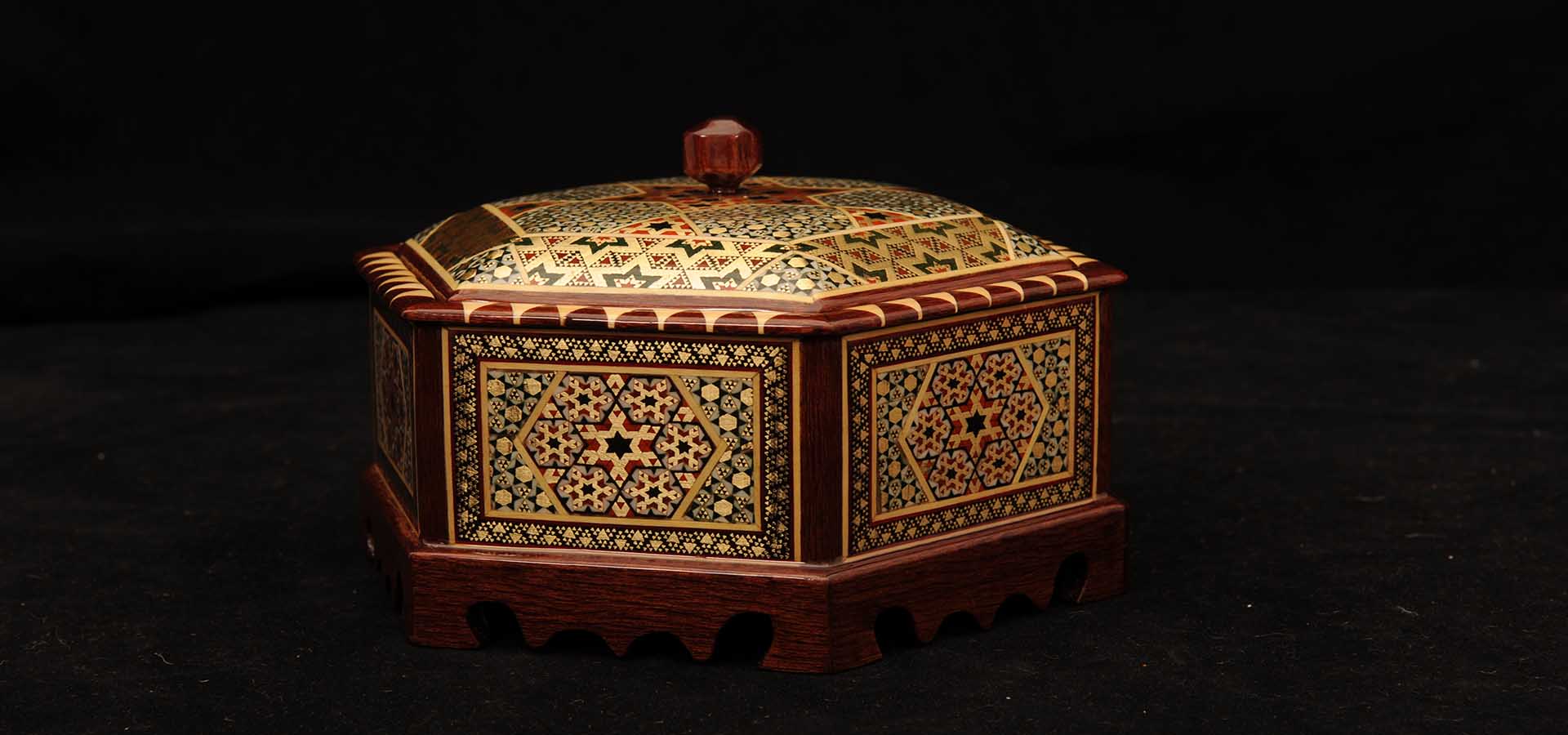
Handicrafts
Khatam Kari
Khatam Kari
Khatam Kari: Marquetry with Wood, Metal, Bone
As one of the most exquisite Iran handicrafts, Khatam Kari is the art of inlaying small pieces of wood, bone, or metal on the surface of different articles. Incrusted patterns (geometrical shapes, particularly star-shaped) are produced in this Iranian handmade art, with thin sticks of wood (ebony, teak, orange, and rose), brass (for the golden parts), and camel bone (white sections). The sticks are then assembled in triangular beams that are themselves glued in a strict order to create a cylinder with a geometrical motif, such as a six-branch star included in a hexagon. The cylinders are cut into shorter ones and then compressed and dried between two wooden plates. These sections are ready to be plated and glued on the object, before lacquer finishing. Among all handicrafts of Iran, Khatamkari is highly elaborated. In each cubic centimeter of space, up to approximately 250 pieces of metal, bone (usually camel bone), ivory, and wood are laid side by side. Dating back to the Safavid era, Khatam Kari is one of the oldest Persian handicrafts, still practiced in Isfahan, Shiraz, and Kerman.

Handicrafts
Isfahan’s Mina Kari
Isfahan’s Mina Kari
Minakari is the art of colouring and ornamenting the surface of copper by fusing brilliant colours that are decorated in intricate designs. Usually, copper is chosen and shaped by an expert coppersmith.
The patterns of Iranian enamel work is traditional designs depending on the taste of the artist. It is then outlined by the engraver to make the enamel adhere firmly to the metal.
Minakari is the art ofThis splendid art (produced by lots of Persian handicraft suppliers) is applied in making wall hanging plates, home décor, candy dishes, vases, and jewelry. As a well-known Sassanid handicraft of Iran, Mina Kari is being observed on the doors and chandeliers of vintage palaces, mansions, and shrines that you may visit during an Iran historical tour.
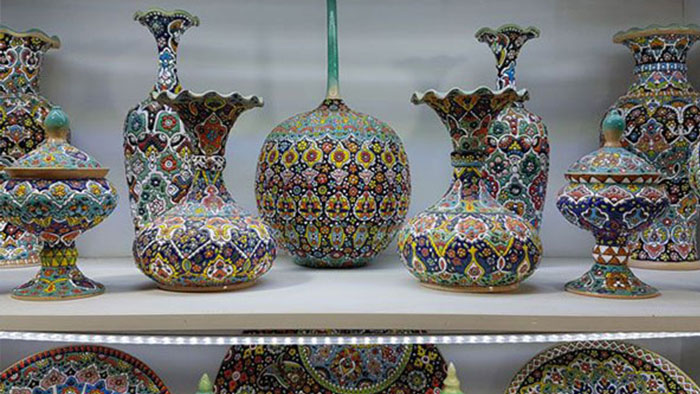
Handicrafts
Hamedan’s Mina Kari
Hamedan’s Mina Kari
Hamedan’s Minakari is the art of colouring and ornamenting the surface of ceramics by fusing brilliant colours that are decorated in intricate designs.

Handicrafts
Termeh Weaving
Termeh Weaving
Luxury Quilted Textile
Termeh is a nice cloth which is woven since Safavi era in Iran.There is an argument between researchers about its origin. Some of them believe that termeh has been made in Kashmir and then brought to Iran.Others say that Iranian have been the innovators of weaving termeh and this material has been taken into concentration like other handicrafts in other parts of the world (Kasmir: Historical region divided between India and Pakistan). But it is a real fact that Iranian termeh in comparison with what ever produced in Kashmir is much better and it has different colours and designs. The only reason that made the Kashmir famous is using a kind of string which is produced by wild goat’s wool. Besides the main place where it lives is Himalaya mountain range located north of India. So Kashmiri termeh weaves have had more availability to it while Iranian had to use fleece.

Handicrafts
Ghalam Zani
Ghalam Zani
Hammer and Nail Metal Engraving
Ghalam Zani is one of the most elegant Persian arts and Iranian handicrafts. Ghalamzani is the art of craving detailed, splendid Persian designs on various metals, including copper, brass, silver, and gold by hammer and chisel (Ghalam). Persian metalwork engraving is known as the best-documented artistic medium from Iran in the Islamic period. Now, you can find various objects and utensils, including plates, trays, candy boxes, candlesticks, etc., which are elegantly engraved in Iran handicraft shops, particularly in Isfahan, Shiraz, and Tehran.
The artistic work s by the artists is the glorious and undeniable.

Handicrafts
Ghalam Kari
Ghalam Kari
Ghalamkar fabric is a type of Textile handprinting or handpainting, patterned Iranian Fabric. The fabric is printed using patterned wooden stamps. The stamps are mostly made of pear wood which has better flexibility and density for carving and long-standing utility. Ghalamkar designs are mostly arabesque, flora and fauna, geometric, pre-Islamic, hunting scenes, polo games, Persian poems, Armenian and Hebrew inscriptions.
A tapestry may be stamped depending on its density and size, between hundreds and tens of thousands of times. For instance, a six-person table-cloth (2 meters by 1.4 meters) should be stamped about 580 times in a normal job, while with the same size up to 4000 times in an elegant work.
Ghalam Kari
In the final stage, Ghalamkar is steamed for at least an hour to stabilize their designs. Then, taken to the riverbed and kept to be soaked well along the running water. Afterward, the pieces are boiled in large copper vessels containing stabilizers. At the same time, they are turned upside-down by some wooden sticks and washed again in the Zayandeh Rood, then spread on the banks to dry out. Esfahan is one of the most important Ghalamkar producing cities throughout the world.

Handicrafts
Monabat Kari (Wood Carving art)
Monabat Kari (Wood Carving art)
Monabat Kari is a branch of wood industry that is considered an artistic technique. It involves carving on wood and a woodcarver is someone who does the carving on the wood. This is a Persian Handicraft dating back to a time where humans acquainted with sharp tools and started to cut wood. In Iran, it has a long history and is a reminder of the past. It can be argued that the Iranian wood carving art history goes back to the first time Iranian got to know wood, making the history of wood inseparable from the history of Monabat Kari, therefore, wood carving has come a long way in reaching the present state. Currently, this art is a prevalent activity all over Iran with cities like Golpayegan, Esfahan, Shiraz, Abade, Malayer, Shahrod, etc, being the leaders.
Choosing the right wood is one of the most essential steps in wood carving art.

Handicrafts
Moaragh Kari (Wood Inlaid Working)
Moaragh Kari (Wood Inlaid Working)
Wood Inlaid (Moaragh) is the art of substitution of the different parts of a design by colored pieces of wood and integrating them with each other in order to decorate the surface of a tableau or other wooden understructures. Although the beginning of the emergence of this art is unknown, but it seems that India is the main birthplace of this art. Lexically Inlaid (Moaragh) means a set comprised of tiny pieces joined together to form a mechanism. In wood inlaid working, according to the delicacy and complication of the design, different pieces of wood with a high variety of colors and also shell, bone and metal are used in order to improve the quality of the manifestation of the work.
Moaragh Kari (Wood Inlaid Working)
In order to implement the job, the design is stuck to a three-ply piece of board and based on its lines all the pieces are numbered, then very carefully cut by means of a coping saw and every piece is used as a pattern for cutting desired wood. The three-ply board is connected to the main piece of wood by very tiny nails in such a way that after sawing round the wood, the pattern board and the wood may be easily separated. Having completed the design, the background can also be filled with wooden texture or colored polyester.
Moaragh Kari (Wood Inlaid Working)
In Isfahan the background like the design is substituted with colored woods. Finally, the work is polished so that a smooth surface is obtained. In order to fill the spaces among the cracks, wood glue and filler with the same color as that of the work is used. The cleaner the cutting of the different parts of the design, the better the work-pieces are arranged next to each other with less crack space. Moreover, factors such as coloration, disappearance of the glue trace and nailed points and the strength of the understructure are very important in the valuation of the work. The object which has undergone inlaid working is covered by a coat of clear polyester in the final stage. Wood Inlaid working has different kinds such as wood inlaid-wood carving (Moaragh -Monabat) and wood inlaid working (Moaragh-khatam). These are two techniques in which the objects undergone wood inlaid working process are also decorated by combination of wood carving or inlaid (khatam) pieces.



